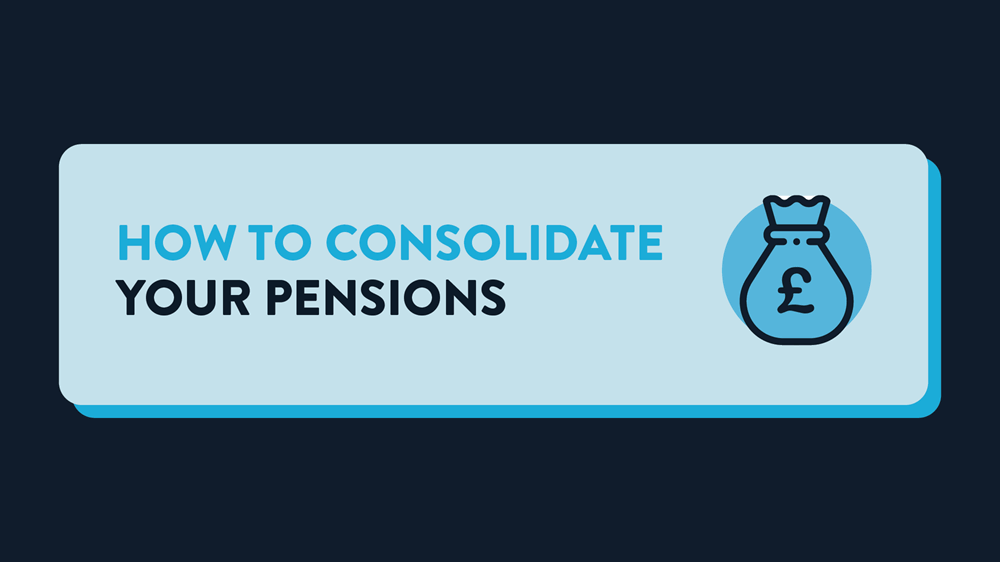If you’ve glanced at the calendar and noticed the date of your retirement party creeping up quickly, perhaps that has you thinking about your future finances. A positive step to help you make the most out of your financial planning is to regularly review your pension pots.
If you haven’t already, perhaps you’re considering consolidating your pension pots to bring them all together in one place — and if so, here’s what you need to know.
What is pension consolidation?
The thing with having many pensions from previous jobs is that it can make retirement planning a bit difficult, especially if you can’t remember which pension schemes you had with certain past employers (and which providers are holding your respective pension pots).
If you want to take control over your savings, consolidating your pensions could help; and by this, we simply mean combining all or some of your pension pots into one.
Why should I consolidate my pensions?
Good question — and it isn’t one size fits all for everyone.
Common reasons for combining your pensions are:
- If you prefer the idea of knowing exactly where your retirement money is.
- If you would like to manage all your past pensions in one place.
- You’re thinking about buying an annuity with your pension pot when you retire.
- You’d like to have some flexibility with the income you receive from your pension.
- The fees may be lower than paying multiple times, across multiple pots.
- Or, you want a more competitive investment plan for your money.
This list isn’t exhaustive (and combining your pension isn’t a decision to rush into), but it gives you an idea of why many people, just like yourself, would consider pension consolidation.
Can I combine all my pensions into one?
Yes, you can combine all your UK-based workplace and personal pensions (like a SIPP: Self-Invested Personal Pension), into one UK-based pension pot. However, if you want to transfer them to a scheme not registered in the UK, then it may be subject to tax.[1]
If you do hold non-UK pensions, then it may be worth speaking to a financial adviser before considering consolidating, as non-UK scheme rules are sometimes very complex.
Something else to be mindful of is if your employer is currently paying into a certain pension pot you have, you may find it tricky to transfer that one to a new provider. Speak to your employer to see if they’ll agree, and your new provider to see if it’s possible to accept the transfer.
And similarly, you may receive a notice to seek independent financial advice – or wish to do this to consider your options – particularly if you are looking to transfer a large amount (or if a particular pension you have offers generous benefits, such as a ‘defined benefit’ pension). You may not want to lose these benefits by ‘transferring out’.
If you're over 50 and are looking for free, impartial pension guidance – especially when it comes to taking money from defined contribution pots – you might want to check out the Pension Wise service, which is a part of the government-backed Money Helper website.
Once you’ve sought that financial advice, and/or are satisfied with proceeding, all you need to do is get started with your new pension provider. You should be able to follow their transfer instructions to combine part – or all – of your past pension pots.
It's important to understand that Wealthify does not accept certain types of pensions, including defined benefits schemes, those with guarantees, or those you’re taking an income from.
Note: Consolidation isn’t applicable to your State Pension as that is automatically calculated for you and handled by HMRC. When you’ll receive a State Pension is dependent on your year of birth (you can check this using the government’s State Pension age checker site), with the amount varying depending on your circumstances and whether you’ve contributed enough National Insurance payments over the years.
Pros and cons of combining pensions
We love a checklist, so here’s one featuring the main pros and cons of pension consolidation for you to consider:
Are there any other pension consolidation considerations?
If you want to move your pension pots somewhere else – including Wealthify – it’s important to familiarise yourself with the following additional considerations first.
Fees: At Wealthify, there’s one low annual management fee of 0.6%. When considering consolidation, please understand how your current fees compare with ours.
Charges: We don’t charge you for transferring to or from Wealthify. However, some pension providers will charge an exit fee for transferring out, so make sure you ask your current providers about their transfer policies.
Benefits: It’s important to check that you won't lose features such as loyalty bonuses.
Being Out of Market: While the transfer takes place, your pension will be ‘out of market’, as your existing provider needs to sell your investments before transferring it as cash.
Pensions Wealthify can’t accept: Please note we can't accept transfers of pensions with safeguarded benefits such as Defined Benefit pensions, those with a guaranteed income, or those where you can get more than your 25% tax-free cash.
No Guarantees: Combining two or more pensions doesn’t guarantee more money in retirement — and investment performance is never guaranteed.
If you’ve decided to transfer a pension, it’s important to check the different rules and you may want to seek financial advice, so you can make the right decision for your later life.
How to consolidate pensions
If you’ve decided to consolidate your pensions, that’s great — but make sure you’re happy with your new provider. It’s always worth shopping around and comparing what different providers have to offer; we’re not just talking about fees here, as it’s also important to look at the service as a whole.

If you don’t know where to start your research, why not consider Wealthify, where consolidating your pensions has never been easier! You get to choose how much to put into your Self-Invested Personal Pension — whether it’s a one-off lump sum or by setting up personal contributions on a monthly basis.
And for every personal contribution you make to your pension, you’ll automatically receive a 25% tax relief top-up on it (to compensate for the Income Tax you’ve already paid).
So, as an example, if you put £800 in a personal pension as a personal contribution, you’ll receive an extra £200 from HMRC. £200 is 25% of £800, meaning you’re effectively getting a 25% top-up on every personal contribution you make. This only applies to the first £60,000 (or 100% of your earnings, whichever is lower) you put in your personal pension – this is your pension annual allowance, and it includes all contributions made by you and the government.
As is the case when opening a Wealthify Personal Pension Plan from scratch, you can choose your investment style (from Cautious to Adventurous) when transferring your pension(s) to us, too. Our team of experts will then manage your money based on your chosen investment style, ensuring your retirement savings are working as hard as you do.
With investing your capital is at risk, and you could get back less than you put in.
How to track down my pensions
Once you’ve chosen your new pension scheme provider, you’ll need to let them know where your existing pensions are. But it’s quite common for people to have lost track over the years. If this sounds like you, don’t worry, it should be pretty easy to lay your hands on them.
All you need to do is go on the HMRC website and fill in a quick online questionnaire. They have a database of employers in the UK, which pension scheme that company uses, and will give the contact details of your past pension providers.
To make the transfer a bit easier, you may want to gather all the paperwork you’ll need to move your pension(s) — this will typically include a copy of your ID and your latest pension statements. Then, you can contact your new provider and let them know you want to consolidate your pots; they should do the hard work for you and contact your old providers to get the transfer process started.
But in some cases, you may have to contact them yourself, especially if they object to the transfer or need further confirmation, but you will be told if this happens. And if anything is needed from you, your new provider will let you know. Pension transfers can take between two week and six months before being completed, depending on the type of pensions you are transferring over.
Pension consolidation tips
Seek independent financial advice
As mentioned earlier, it’s sensible to seek out some independent advice for your pensions if you’re feeling unsure about your options for consolidation.
Pension Wise from MoneyHelper (backed by the government) offer a free, impartial guidance service for people aged over 50, which could be of help to you. Find out more here: www.moneyhelper.org.uk/en/pensions-and-retirement/pension-wise
Use the HMRC pension finder service
And lastly, don’t forget about HMRC’s handy service to locate any lost pension schemes you’ve paid into in the past: www.gov.uk/find-pension-contact-details
Use a pension calculator
Working out how much you need to save in order to retire can be tricky, but luckily, our pension calculator does all the hard work for you.
In four simple steps, you can get a good idea of whether you’re on track or not. Try it today and see what you could get and visit our pension transfer page for more information about Wealthify Personal Pensions.
Please remember that Wealthify is unable to accept any pensions you’re taking an income from, or transfer any pensions with defined benefits or guarantees. For other pensions, you should also consider whether you may lose any other valuable benefits if you transfer, such as loyalty bonuses.
Please remember that, as with all investing, the value of your investments can go down as well as up, and you could get back less than invested.
The tax treatment depends on your individual circumstances and may be subject to change in the future.
Wealthify does not provide financial advice. Please seek financial advice if you are unsure about investing.



